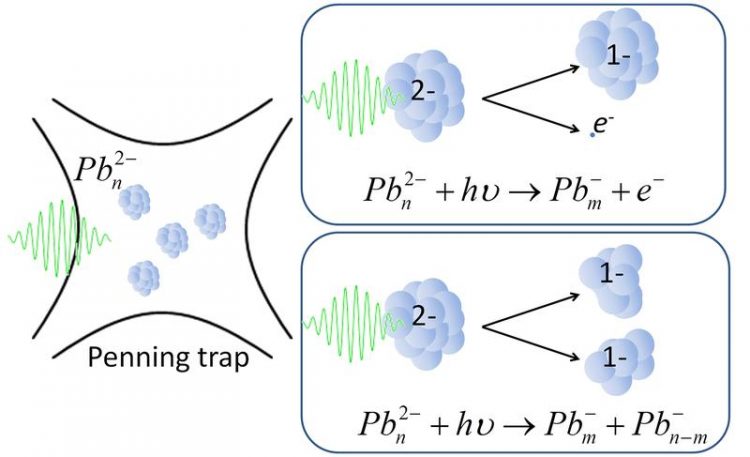Subnano lead particles show peculiar decay behavior

The Figure on the left is a schematic depiction of the laser irradiation of lead particles stored in a so-called Penning ion trap. Grafik: Stephan König
Physicists distinguish between the size ranges of individual atoms and bulk matter. Between these, there are also so-called clusters, particles that can be made up of just a few and up to around a thousand atoms. Due to their size they have properties that differ from individual atoms and the bulk matter.
And what is more, adding or removing just a single atom can substantially change the properties of a cluster. The study of cluster properties is one of the main research areas of the atomic and molecular physics group at the University of Greifswald’s Institute of Physics.
For the investigations that have now been presented, a high-purity lead wire was irradiated with laser pulses. This resulted in a plasma made up of electrons and lead atoms, some of them ionized. The plasma underwent strong cooling which allowed the lead atoms to aggregate, i.e. to form clusters.
The negatively charged clusters were captured in ion traps, further prepared for the actual measurements, and finally the reaction products were analyzed using mass spectrometry.
It had previously been observed that electron and laser irradiation of small negatively charged lead clusters made up of about 20 to approximately 40 atoms decay differently from what was known about other metals: Whilst copper, silver and gold clusters emit either single neutral atoms or their surplus electron, the lead clusters decay into bigger fragments (S. König et al., J. Phys. Chem., 2017, M. Wolfram et al, J. Phys. B 2018, S. König et al., Int. J. Mass Spectrom. (2017)). This decay into bigger pieces only disappears when using larger lead clusters resulting in the known evaporation of single atoms, which is also predicted by modelling small metal balls.
Recently, the studies investigating cluster irradiation of lead clusters by electrons and laser beams have been combined. This resulted in the first observation of the fission of multiply charged negative metal clusters. Furthermore, the decay behavior that deviates from that of the noble metal clusters continues, just like the return to the expected behavior with larger clusters.
These results may also be an indication for deviating behavior in further cluster properties. One of the conjectures based on the present observations is a semiconductor-to-metal transition with increasing size of the lead clusters, whilst even the smallest noble-metal clusters show a metallic behavior.
These results from fundamental research are of interest, for example, to scientists performing research into material science, who are looking for materials with new properties. Nanoparticles are particularly promising. Ideally, their properties could be controlled by their cluster size – although there is still a long way to go before the results can be applied to everyday devices.
The results on fission of multiply charged negative lead clusters appeared in the journal Physical Review Letters 120, 163001 – Published 16 April 2018
Fission of polyanionic metal clusters, S. König, A. Jankowski, G. Marx, L. Schweikhard, M. Wolfram, Physical Review Letters 120, 163001 (2018)
DOI: https://doi.org/10.1103/PhysRevLett.120.163001
https://journals.aps.org/prl/abstract/10.1103/PhysRevLett.120.163001
The photos can be downloaded and used for free for editorial purposes in combination with this press release. You must name the respective author of the images. To the photos
Contact at the University of Greifswald
Dr. Stephan König and Prof. Dr. Lutz Schweikhard
Institute of Physics
Felix-Hausdorff-Straße 6, 17487 Greifswald
Tel.: +49 3834 420 4700
stephan.koenig@physik.uni-greifswald.de
lschweik@physik.uni-greifswald.de
https://physik.uni-greifswald.de/ag-schweikhard/
https://journals.aps.org/prl/abstract/10.1103/PhysRevLett.120.163001
https://journals.aps.org/prl/abstract/10.1103/PhysRevLett.120.163001
https://tinyurl.com/y7bhnvjn
Media Contact
All latest news from the category: Physics and Astronomy
This area deals with the fundamental laws and building blocks of nature and how they interact, the properties and the behavior of matter, and research into space and time and their structures.
innovations-report provides in-depth reports and articles on subjects such as astrophysics, laser technologies, nuclear, quantum, particle and solid-state physics, nanotechnologies, planetary research and findings (Mars, Venus) and developments related to the Hubble Telescope.
Newest articles

Making diamonds at ambient pressure
Scientists develop novel liquid metal alloy system to synthesize diamond under moderate conditions. Did you know that 99% of synthetic diamonds are currently produced using high-pressure and high-temperature (HPHT) methods?[2]…

Eruption of mega-magnetic star lights up nearby galaxy
Thanks to ESA satellites, an international team including UNIGE researchers has detected a giant eruption coming from a magnetar, an extremely magnetic neutron star. While ESA’s satellite INTEGRAL was observing…

Solving the riddle of the sphingolipids in coronary artery disease
Weill Cornell Medicine investigators have uncovered a way to unleash in blood vessels the protective effects of a type of fat-related molecule known as a sphingolipid, suggesting a promising new…





















